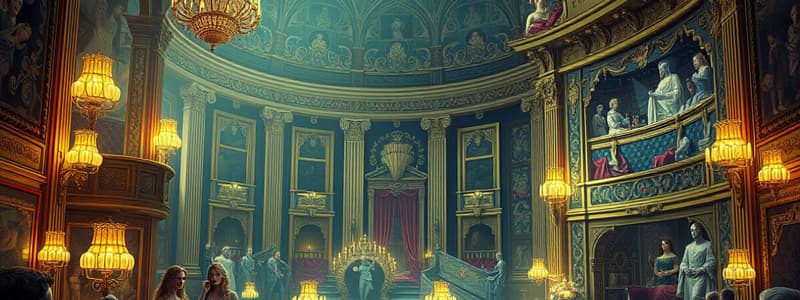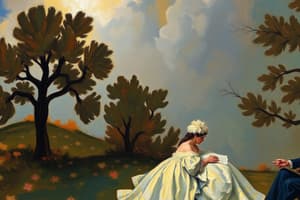Podcast
Questions and Answers
Describe 3 differences between Opera in the Baroque and Classical Period.
Describe 3 differences between Opera in the Baroque and Classical Period.
- Classical operas were open for everyone, while Baroque operas were mainly for people with higher wealth. 2. Baroque music was more for dance, whereas Classical music constantly changes. 3. The Baroque period had more polyphonic texture, while the Classical period had more homophonic texture.
Discuss instrumental music in the Classical Period. Please include which instruments became important in this music.
Discuss instrumental music in the Classical Period. Please include which instruments became important in this music.
Orchestras used many brass and wind instruments, including trumpets, trombones, Basset clarinets, and Basset horns.
List one major change in the orchestra from the Baroque to the Classical Period.
List one major change in the orchestra from the Baroque to the Classical Period.
The dynamics increased from only two in the Baroque period (forte and piano) to a variety of dynamics in the Classical period.
List 3 different instrumental forms of music that had great stylistic advances during the Classical period.
List 3 different instrumental forms of music that had great stylistic advances during the Classical period.
Discuss the 4-movement form of the Symphony.
Discuss the 4-movement form of the Symphony.
Discuss Haydn's Surprise Symphony.
Discuss Haydn's Surprise Symphony.
Discuss how music connected to art in the Classical Period.
Discuss how music connected to art in the Classical Period.
What are the birth and death dates of Wolfgang Amadeus Mozart?
What are the birth and death dates of Wolfgang Amadeus Mozart?
Discuss Joseph Haydn's contributions and career.
Discuss Joseph Haydn's contributions and career.
Study Notes
Differences in Opera: Baroque vs. Classical Period
- Baroque opera was exclusive to the wealthy, while Classical opera was accessible to a broader audience.
- Music in the Baroque period prioritized dance, while the Classical period emphasized continual change in musical composition.
- Baroque music featured more polyphonic textures, contrasting with the Classical era's focus on homophonic textures.
Instrumental Music in the Classical Period
- Orchestras expanded to include brass and woodwind instruments.
- Key brass instruments included trumpets and buccin trombones.
- Important woodwind instruments were the basset clarinet and basset horn.
Orchestra Changes: Baroque to Classical
- Baroque music predominantly utilized two dynamics (forte and piano), while Classical music introduced a wider variety of dynamic expressions.
Instrumental Forms with Stylistic Advances
- Sonata
- Concerto
- Symphony
Four-Movement Symphony Structure
- Total duration of a symphony is generally 20-25 minutes.
- The first movement is usually fast and often in sonata form, which features instrumental solos.
- The second movement is slower and typically lyrical in style.
- The third movement, like the first, is fast and often dance-based.
- The finale, or fourth movement, is the most extensive and loudest.
Haydn's Surprise Symphony
- Known for an upbeat and sanguine character, diverging from the gloom of earlier periods.
- The second movement of this symphony features rapid tempos, contrasting the common slow tempo of second movements.
Connection Between Music and Art in the Classical Period
- Both music and art were reactions against preceding artistic styles.
- Neoclassicism inspired both the music and visual arts, drawing from Greco-Roman cultural forms.
- Key elements in both art and music included form, symmetry, and rationalism.
Wolfgang Amadeus Mozart
- Born on January 27, 1756, in Salzburg; died December 5, 1791.
- Renowned as a prolific composer of the Classical era.
- Displayed exceptional musical talent from a young age, mastering keyboard and violin by five, composing, and performing for European royalty early in his career.
Joseph Haydn
- Played a crucial role in developing chamber music, particularly the piano trio.
- Earned titles like "Father of the Symphony" and "Father of the String Quartet."
- Worked primarily as a court musician for the Esterházy family, leading to a unique originality in his composition.
- Despite isolation, his music gained widespread circulation, making him a celebrated composer in Europe.
Studying That Suits You
Use AI to generate personalized quizzes and flashcards to suit your learning preferences.
Description
Explore the distinctions between Opera in the Baroque and Classical periods through these flashcards. Learn about accessibility, musical style, and performance practices that evolved over time. Perfect for music students and enthusiasts alike!





